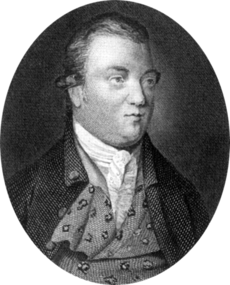
Marmaduke Tunstall
Encyclopedia

England
England is a country that is part of the United Kingdom. It shares land borders with Scotland to the north and Wales to the west; the Irish Sea is to the north west, the Celtic Sea to the south west, with the North Sea to the east and the English Channel to the south separating it from continental...
ornithologist and collector. He was the author of Ornithologica Britannica (1771), probably the first British work to use binomial nomenclature
Binomial nomenclature
Binomial nomenclature is a formal system of naming species of living things by giving each a name composed of two parts, both of which use Latin grammatical forms, although they can be based on words from other languages...
.
Tunstall was born at Burton Constable
Burton Constable
Burton Constable is a village and civil parish in the East Riding of Yorkshire, England. It is located approximately north east of Hull city centre and south east of the village of Skirlaugh....
in Yorkshire
Yorkshire
Yorkshire is a historic county of northern England and the largest in the United Kingdom. Because of its great size in comparison to other English counties, functions have been increasingly undertaken over time by its subdivisions, which have also been subject to periodic reform...
. In 1760 he succeeded to the family estates of Scargill
Scargill
Scargill is a hamlet in the Pennines of England, situated close to the River Greta. It was historically located in the North Riding of Yorkshire but along with the rest of the former Startforth Rural District it was transferred to County Durham for administrative and ceremonial purposes on 1 April...
, Hutton, Long Villers and Wycliffe
Wycliffe, County Durham
Wycliffe is a village on the south bank of the River Tees in the North East of England, situated a short distance to the east of Barnard Castle...
. Being a Catholic, he was educated at Douai
Douai
-Main sights:Douai's ornate Gothic style belfry was begun in 1380, on the site of an earlier tower. The 80 m high structure includes an impressive carillon, consisting of 62 bells spanning 5 octaves. The originals, some dating from 1391 were removed in 1917 during World War I by the occupying...
in France. On completing his studies he took up residence in Welbeck Street, London
London
London is the capital city of :England and the :United Kingdom, the largest metropolitan area in the United Kingdom, and the largest urban zone in the European Union by most measures. Located on the River Thames, London has been a major settlement for two millennia, its history going back to its...
, where he formed an extensive museum, as well as a large collection of living birds and animals. After his marriage in 1776 the museum was moved to Wycliffe, and at the time was one of the finest in England.
Tunstall became a fellow of the Society of Antiquaries of London
Society of Antiquaries of London
The Society of Antiquaries of London is a learned society "charged by its Royal Charter of 1751 with 'the encouragement, advancement and furtherance of the study and knowledge of the antiquities and history of this and other countries'." It is based at Burlington House, Piccadilly, London , and is...
at the age of twenty-one, and in 1771 was elected a fellow of the Royal Society
Royal Society
The Royal Society of London for Improving Natural Knowledge, known simply as the Royal Society, is a learned society for science, and is possibly the oldest such society in existence. Founded in November 1660, it was granted a Royal Charter by King Charles II as the "Royal Society of London"...
.
Tunstall died at Wycliffe, and his estates passed to his half-brother, William Constable. Constable invited Thomas Bewick
Thomas Bewick
Thomas Bewick was an English wood engraver and ornithologist.- Early life and apprenticeship :Bewick was born at Cherryburn House in the village of Mickley, in the parish of Ovingham, Northumberland, England, near Newcastle upon Tyne on 12 August 1753...
to Wycliffe where he spent two months making drawings from the bird specimens. The collection was eventually purchased by the Newcastle Society in 1822, and formed the basis of the Newcastle Museum.

